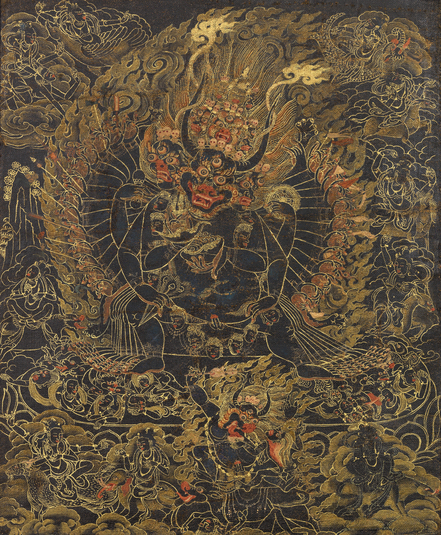
Item: Vajrabhairava (Buddhist Deity) - Solitary (Ekavira)
| Origin Location | Tibet |
|---|---|
| Date Range | 1600 - 1699 |
| Lineages | Sakya, Kagyu and Buddhist |
| Material | Ground Mineral Pigment, Black Background on Cotton |
| Collection | Private |
Classification: Deity
Appearance: Animal-Feature
Gender: Male
Vajrabhairava Ekavira (Tibetan: dor je jig je, pa wo chig pa. English: The Solitary Hero Vajra Terror) a wrathful tantric form of the Mahayana bodhisattva Manjushri. As Vajrabhairava, Manjushri performs the function of being a complex meditational deity popular with all forms of the new Tantric schools of Tibetan Buddhism from the 2nd millenium to the present.
The ferocious Vajrabhairava is black in colour with nine faces, thirty-four hands and sixteen legs. The main face is that of a buffalo, with a red face above and the slightly angry yellow face of Manjushri placed on top. Flames entwine the two horns and shoot fire from the tips. The three right faces, stacked one above the other, are blue, red and yellow and the three left are white, smoky coloured and black. Each face has three large round eyes, bared fangs and each conveys a different emotional expression; yellow hair flows upward like rising flames. The first pair of hands hold a curved knife and skullcup at the heart. The remaining hands hold a multitude of weapons with the last set also holding the fresh outstretched hide of an elephant. Each face is adorned with a crown of five skulls and bone earrings. He wears a snake necklace and a garland of fifty heads. The right legs are bent pressing down on a variety of creatures and gods. The left legs are extended straight and press upon eight birds and various gods. Above a sun disc and multi-coloured lotus blossom he stands in the middle of a mass of orange flames of pristine awareness.
At the bottom center is the special protector for the Vajrabhairava cycle of practice, Yama Dharmaraja, black, with one face and two hands holding a stick and noose, embraced by the consort Chamundi and mounted atop a buffalo; surrounded by flames. Surrounding the central figure are worldly gods and retinue deities from the mandala.
As a meditational deity Vajrabhairava, also sometimes referred to as Yamantaka, belongs to the Bhairava and Yamari class of tantras and specifically arises from the Vajrabhairava Root Tantra (Tibetan: jig je tsa gyu). All of those belong to the method (father) classification of Anuttaryoga Tantra. The practice of Bhairava is common to the three Sarma (new) Schools: Sakya, Kagyu and Gelugpa. Among the Sakya it is counted as one of the four main tantric deities along with Hevajra, Guhyasamaja and Chakrasamvara (Tibetan: gyu de shi). Amongst the various Kagyu Schools the Drigungpa have been strong upholders of the practice. There are numerous forms and styles of practice from the very complex with numerous deities to the very concise with a single Heruka form (one face and two arms). From the many lineages to enter Tibet the main ones were those of Jowo Atisha, Rwa Lotsawa and Mal Lotsawa.
Mal Lineage: the lord of Refuge Vajradhara, Arya Manjushri, Acharya Buddha Jnana, Dipamkara Zangpo, Brahmin Shridhara, the pandita and mahasiddha Naropa, Minyam Dorje Khol, the Nepali of Yerang Bharo Chagdum, Mal Lotsawa Lodro Dragpa, Sachen Kunga Nyingpo (1092-1158), etc.
The style of painting is black ground (Tib.: nag thang) - gold outline on a black background with various colours used for detailing the figures. Traditionally this style of a black ground is reserved for wrathful figures.
Jeff Watt 6-2018
Collection: Sotheby's, Painting (September 2022; New York)
Collection: Sotheby's New York (Painting, March 2023)
Collection: Sotheby's, New York (March, 2025)
Buddhist Deity: Vajrabhairava Main Page
Collection of Anna Maria Rossi & Fabio Rossi
Painting: Vajrabhairava (Blackground)
Collection: Bonhams NY, March 2018
Buddhist Deity: Vajrabhairava (Stacked Faces, Painting)
